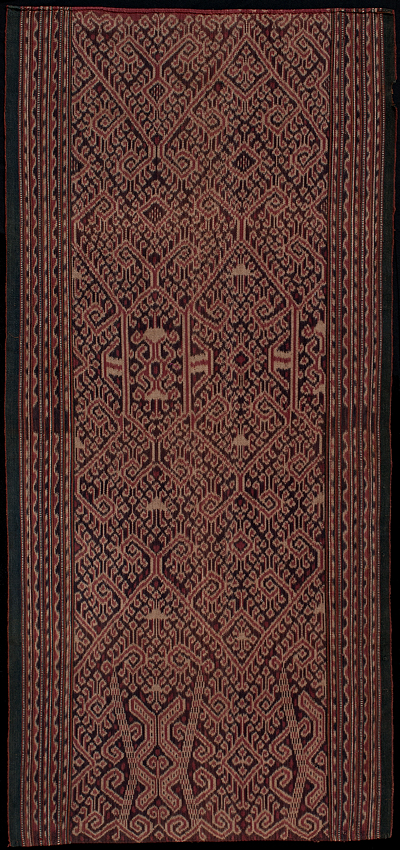| |
 
 | | | |
306 Borneo, Kalimantan
Kain kebat (skirt)  
| | Locale: | Embaloh Iban, most of whom live in the Kapuas Ulu regency of Kalimantan Barat. See additional info on Embaloh Dayak. | | Period: | Early 20th c. | | Yarn: | Cotton, hand-spun, medium | | Technique: | Warp ikat | | Panels: | 1 | | Size: | 52 x 112 cm (1' 8" x 3' 8") LW: 2.15 | | Weight: | 201 g (7.1 oz), 345 g/m2 (1.13 oz/ft2) | | Design: | The design could not yet be identified. Most likely it is a combination of several motifs. As such it is likely to be ancient, as it has a fairly wide distribution. The drawing was created, as are many Ibanic skirts, with a triple repeat of the basic ikated motif, with the middle of the three flipped over the longitudinal axis. | | Comment: | The design has a deep inner strength, very peaceful, perhaps because it shows high class ability without a blatant display of virtuosity. Note how the actual drawing is done in red, then outlined in white, one of the arrows in the Ibanic weaver's qa technique that produces high contrast. Because the high contrast between the dyed areas and the white highlights makes the design glow, it is very effective in low light. High contrast was achieved by intense saturation of the dark, chocolaty engkerbai and of topical overdying with indigo in the interstitial spaces which produced a dark purple. The finest details were done on six thread pairs, i.e. just two for each warp bed. The cloth was woven 'two under, two over', with two warp threads in parallel - a hallmark of Kalimantan ikat - and an ochre weft that balances the cool tonality of the indigo overdye. One expert said: 'It is a very nice piece showing how the weaver has melded the kukut with the smaller hooks. I would have married this weaver.' | | Background: | Chapters on Borneo and Kalimantan. | | Compare: | 212 220 229 242 300 | | Sources: | Embaloh provenance was provided by the source. Michael Heppell, expert on the material culture of the complex Sarawak/Kalimantan border area, marked by multiple migrations and resulting interculturality, sees no reason to doubt it. The probably archaic design is used by several groups. One, an antique in the Heppell collection, is nearly identical, and comes from the Baleh. | | |

©Peter ten Hoopen, 2025
All rights reserved.
|
|


